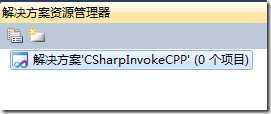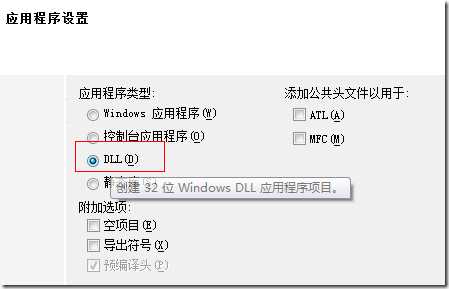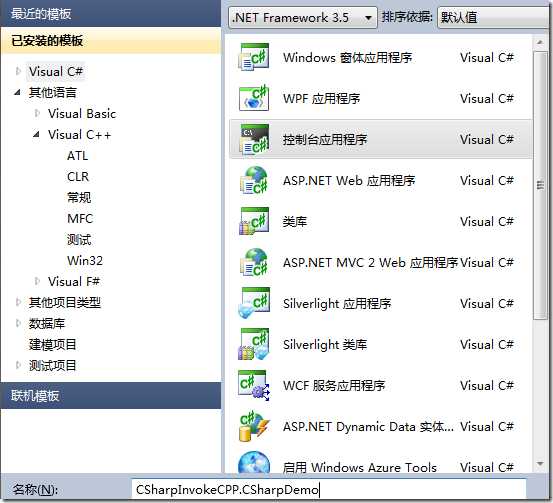标签:
背景
在项目过程中,有时候你需要调用非C#编写的DLL文件,尤其在使用一些第三方通讯组件的时候,通过C#来开发应用软件时,就需要利用DllImport特性进行方法调用。本篇文章将引导你快速理解这个调用的过程。
步骤
1. 创建一个CSharpInvokeCPP的解决方案:

2. 创建一个C++的动态库项目:

3. 在应用程序设置中,选择“DLL”,其他按照默认选项:

最后点击完成,得到如图所示项目:

我们可以看到这里有一些文件,其中dllmain.cpp作为定义DLL应用程序的入口点,它的作用跟exe文件有个main或者WinMain入口函数是一样的,它就是作为DLL的一个入口函数,实际上它是个可选的文件。它是在静态链接时或动态链接调用LoadLibrary和FreeLibrary时都会被调用。详细内容可以参考(http://blog.csdn.net/benkaoya/archive/2008/06/02/2504781.aspx)。
4. 现在我们打开CSharpInvokeCPP.CPPDemo.cpp文件:
现在我们加入以下内容:
// CSharpInvokeCpp_CppDemo.cpp : 定义 DLL 应用程序的导出函数。
//
#include "stdafx.h"
extern "C" __declspec(dllexport) int Add(int x, int y)
{
return x + y;
}
extern "C" __declspec(dllexport) int Sub(int x, int y)
{
return x - y;
}
extern "C" __declspec(dllexport) int Multiply(int x, int y)
{
return x * y;
}
extern "C" __declspec(dllexport) int Divide(int x, int y)
{
return x / y;
}
extern "C" 包含双重含义,从字面上即可得到:首先,被它修饰的目标是“extern”的;其次,被它修饰的目标是“C”的。而被extern "C"修饰的变量和函数是按照C语言方式编译和连接的。
__declspec(dllexport)的目的是为了将对应的函数放入到DLL动态库中。
extern "C" __declspec(dllexport)加起来的目的是为了使用DllImport调用非托管C++的DLL文件。因为使用DllImport只能调用由C语言函数做成的DLL。
5. 编译项目程序,最后在Debug目录生成CSharpInvokeCPP.CPPDemo.dll和CSharpInvokeCPP.CPPDemo.lib

可以发现对外的公共函数上包含这四种“加减乘除”方法。
6. 现在来演示下如何利用C#项目来调用非托管C++的DLL,首先创建C#控制台应用程序:

7. 在CSharpInvokeCSharp.CSharpDemo项目上新建一个CPPDLL类,编写以下代码:
public class CppDLL
{
[DllImport("CSharpInvokeCpp_CppDemo.dll", CallingConvention = CallingConvention.Cdecl)]
public static extern int Add(int x, int y);
[DllImport("CSharpInvokeCpp_CppDemo.dll", CallingConvention = CallingConvention.Cdecl)]
public static extern int Sub(int x, int y);
[DllImport("CSharpInvokeCpp_CppDemo.dll", CallingConvention = CallingConvention.Cdecl)]
public static extern int Multiply(int x, int y);
[DllImport("CSharpInvokeCpp_CppDemo.dll", CallingConvention = CallingConvention.Cdecl)]
public static extern int Divide(int x, int y);
}
DllImport作为C#中对C++的DLL类的导入入口特征,并通过static extern对extern “C”进行对应。其中CallingConvention是声明函数的调用方式,也就是确定函数参数的入栈顺序。
8. 另外,记得把CPPDemo中生成的DLL文件拷贝到CSharpDemo的bin\Debug或者bin\Release目录下。另外,如果嫌一直拷贝麻烦,你也可以通过设置DLL工程的项目属性,【项目属性】->【配置属性】->【常规】中的输出目录:

这样,每次重新编译的DLL文件就自动的输出到了使用它的C#工程的目录下。
9. 然后在C#的测试类的Main入口编写测试代码:
static void Main(string[] args)
{
int result = CPPDLL.Add(10, 20);
Console.WriteLine("10 + 20 = {0}", result);
result = CPPDLL.Sub(30, 12);
Console.WriteLine("30 - 12 = {0}", result);
result = CPPDLL.Multiply(5, 4);
Console.WriteLine("5 * 4 = {0}", result);
result = CPPDLL.Divide(30, 5);
Console.WriteLine("30 / 5 = {0}", result);
Console.ReadLine();
}
测试代码运行结果:

10. 以上的方法只能通过静态方法对于C++中的函数进行调用。那么怎样通过静态方法去调用C++中一个类对象中的方法呢?现在我在CPPDemo项目中添加一个头文件userinfo.h:
class UserInfo {
private:
char* m_Name;
int m_Age;
public:
UserInfo(char* name, int age)
{
m_Name = name;
m_Age = age;
}
virtual ~UserInfo(){ }
int GetAge() { return m_Age; }
char* GetName() { return m_Name; }
};
在CSharpInvokeCPP.CPPDemo.cpp中,添加一些代码:
#include <malloc.h>
#include "userinfo.h"
typedef struct
{
char name[32];
int age;
}User;
UserInfo *userInfo;
extern "C" __declspec(dllexport) User* Create(char *name, int age)
{
User *user = (User *)malloc(sizeof(User));
userInfo = new UserInfo(name, age);
strcpy(user->name, userInfo->GetName());
user->age = userInfo->GetAge();
return user;
}
这里声明一个结构,包括name和age,这个结构是用于和C#方面的结构作个映射。
注意:代码中的User*是个指针,返回也是一个对象指针,这样做为了防止方法作用域结束后的局部变量的释放。
strcpy是个复制char数组的函数。
11. 在CSharpDemo项目中CPPDLL类中补充代码:
[DllImport("CSharpInvokeCPP.CPPDemo.dll")]
public static extern IntPtr Create(string name, int age);
[StructLayout(LayoutKind.Sequential)]
public struct User
{
[MarshalAs(UnmanagedType.ByValTStr, SizeConst = 32)]
public string Name;
public int Age;
}
其中这里的结构User就和C++中的User对应。
12. 在Program.cs中补充代码:
IntPtr ptr = CppDLL.Create("stemon", 26);
CppDLL.User user = (CppDLL.User)System.Runtime.InteropServices.Marshal.PtrToStructure(ptr, typeof(CppDLL.User));
Console.WriteLine("Name: {0}, age: {1}", user.name, user.age);
这里结构指针首先转换成IntPtr句柄,然后通过Marshal.PtrToStructrue转换成你所需要的结构。
注意:
非托管的代码中如果有类,使用的方法就是上面的这个样子,把类转换成C语言的结构体,因为DLL只能是C语言的。如果非托管的类是一个功能类,那么就不用结构体了,直接使用C语言的一些函数调用非托管类的成员函数,也就是说把C语言的函数当做DLL对外的接口,有C语言的这些接口函数去调用非托管代码的功能函数。但是要在调用其他函数之前利用一个Init()函数,实例化出来一个类的对象。(当然了,如果所有的成员函数都是静态的,那就不用实例对象了,直接使用类调用函数就可以了。)
PtrToStructure这个函数
Marshal.PtrToStructure 方法 (IntPtr, Type) ptr 类型:System.IntPtr 指向非托管内存块的指针。 structureType 类型:System.Type 待创建对象的类型。 此对象必须表示格式化类或结构。 返回值 类型:System.Object 一个托管对象,包含 ptr 参数指向的数据。
将数据从非托管内存块封送到新分配的指定类型的托管对象。
using System;
using System.Runtime.InteropServices;
public struct Point
{
public int x;
public int y;
}
class Example
{
static void Main()
{
// Create a point struct.
Point p;
p.x = 1;
p.y = 1;
Console.WriteLine("The value of first point is " + p.x + " and " + p.y + ".");
// Initialize unmanged memory to hold the struct.
IntPtr pnt = Marshal.AllocHGlobal(Marshal.SizeOf(p));
try
{
// Copy the struct to unmanaged memory.
Marshal.StructureToPtr(p, pnt, false);
// Create another point.
Point anotherP;
// Set this Point to the value of the
// Point in unmanaged memory.
anotherP = (Point)Marshal.PtrToStructure(pnt, typeof(Point));
Console.WriteLine("The value of new point is " + anotherP.x + " and " + anotherP.y + ".");
}
finally
{
// Free the unmanaged memory.
Marshal.FreeHGlobal(pnt);
}
}
}
标签:
原文地址:http://www.cnblogs.com/stemon/p/4526950.html